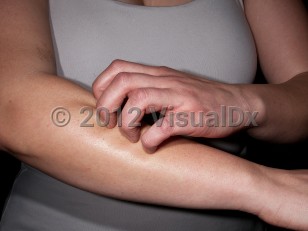Pruritus without rash in Adult
Alerts and Notices
Important News & Links
Synopsis

Generalized itching without a rash can be an important symptom of internal conditions such as biliary obstruction, renal failure (acute, chronic), hyperthyroidism, Hodgkin disease, other lymphomas, and other myeloproliferative diseases. The connection, if any, between pruritus and solid malignancies is tenuous and exceedingly rare except when, for example, a tumor causes biliary obstruction. Medications can also cause generalized pruritus without a rash.
Diffuse itch with a prickling character that develops immediately after any water contact and lacks associated visible skin changes is called aquagenic pruritus and may be a sign of polycythemia vera. It has also been associated with myelodysplastic syndrome and hypereosinophilic syndrome. Rarely it has been reported as occurring with essential thrombocythemia and myelofibrosis. Some medications have been reported to induce the condition as well.
Localized itching, often with a burning or stinging character, can occur as a consequence of isolated peripheral sensory neuropathies. These abnormal sensations may be described as dysesthetic, paresthetic, or neuropathic. Itch localized to the upper back may represent notalgia paresthetica. Itch localized to the forearms may represent brachioradial pruritus. Dysesthesia of the scalp can occur as a consequence of cervical spine disease. Intense itching of the scalp also occurs in dermatomyositis. On occasion, a localized neuropathic itch such as brachioradial pruritus may trigger generalized pruritus.
Generalized pruritus in the setting of immunocompromise can be a sign of lymphoma, drug reactions, and all the other conditions associated with generalized itch.
Pruritus of the elderly is probably a consequence of age-related sensory neuropathy but is ordinarily considered a diagnosis of exclusion.
Related topic: HIV/AIDS-related pruritus
Codes
L29.8 – Other pruritus
SNOMEDCT:
279333002 – Pruritic disorder
Look For
Subscription Required
Diagnostic Pearls
Subscription Required
Differential Diagnosis & Pitfalls

Subscription Required
Best Tests
Subscription Required
Management Pearls
Subscription Required
Therapy
Subscription Required
Drug Reaction Data
Subscription Required
References
Subscription Required
Last Updated:05/08/2022

